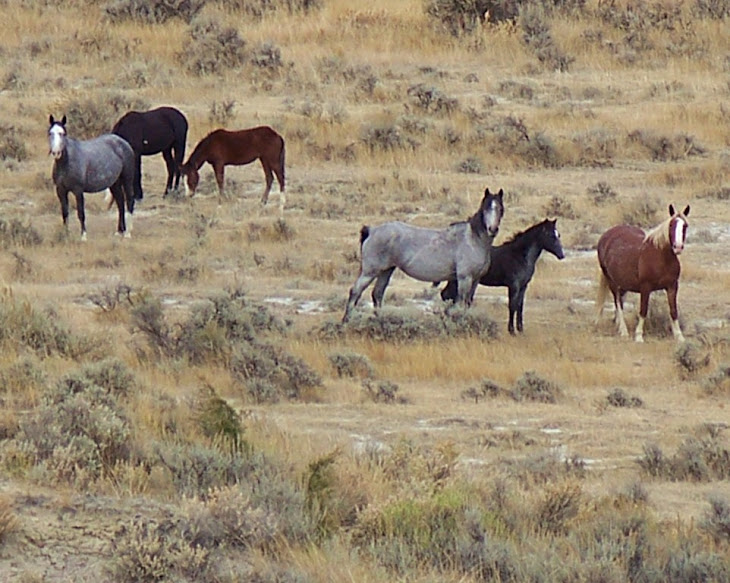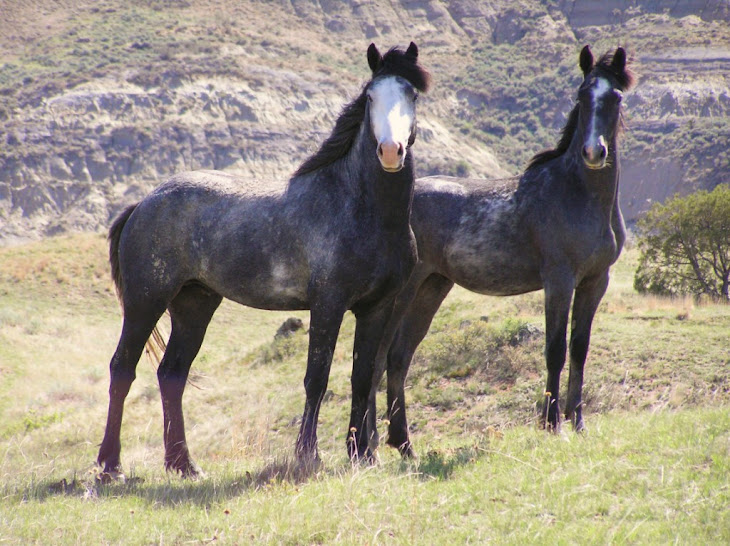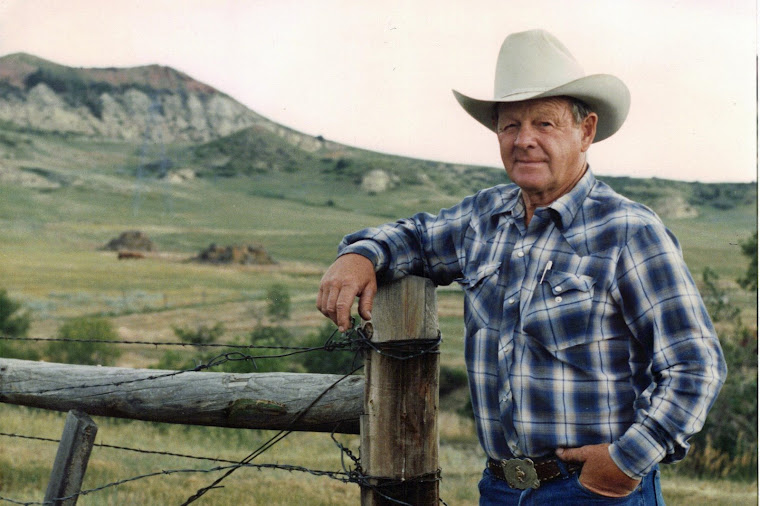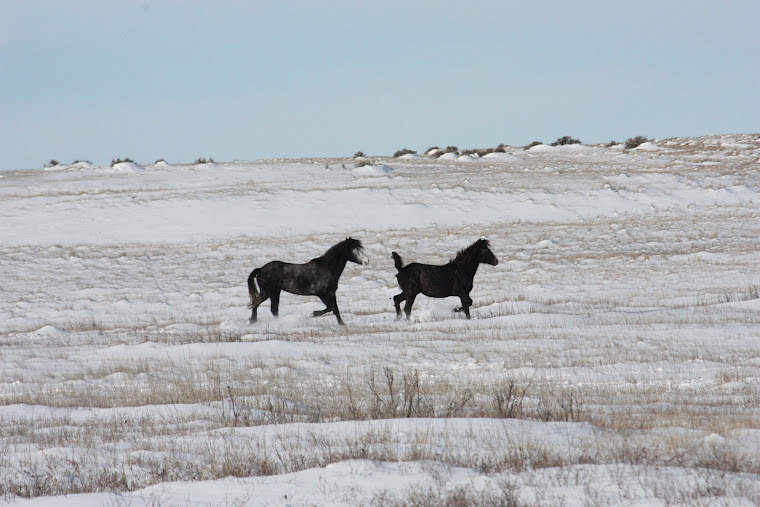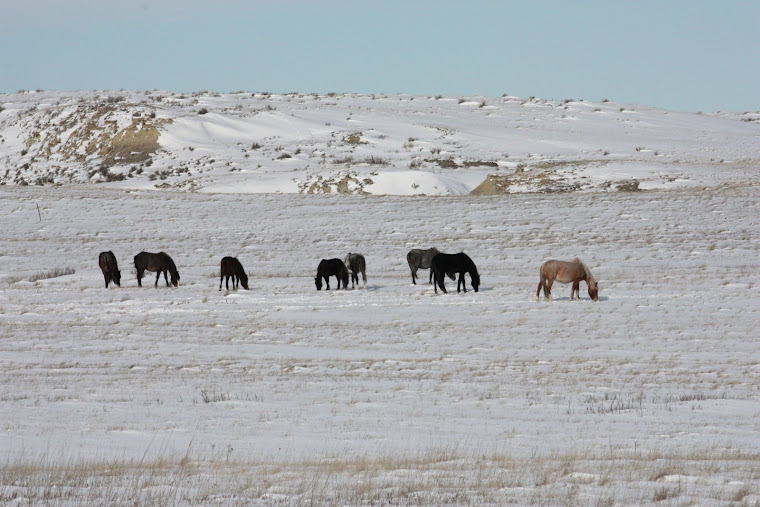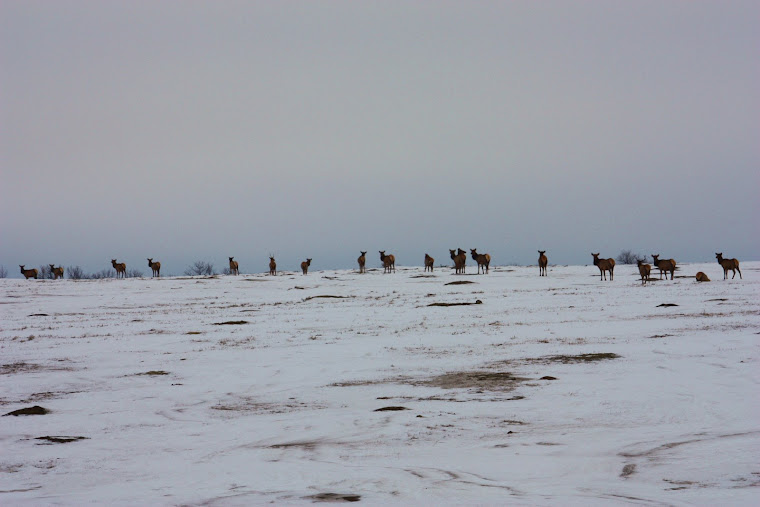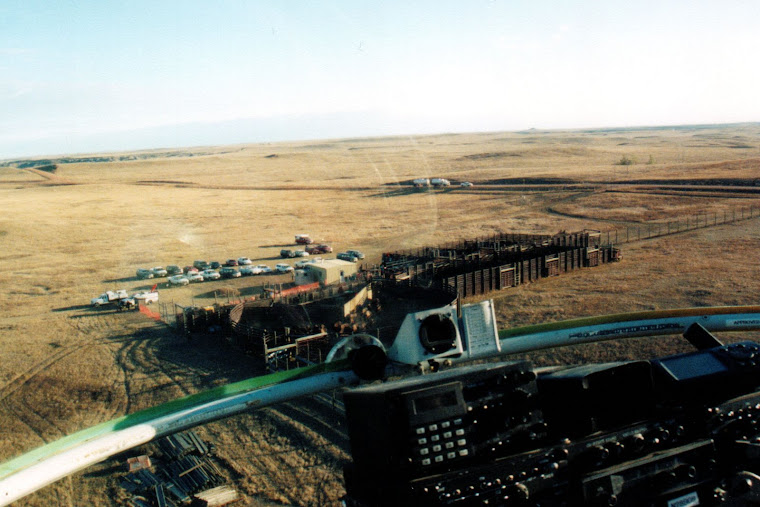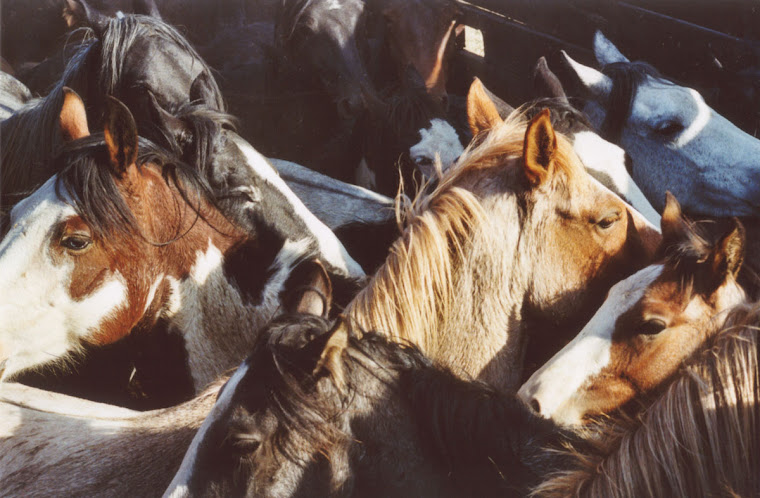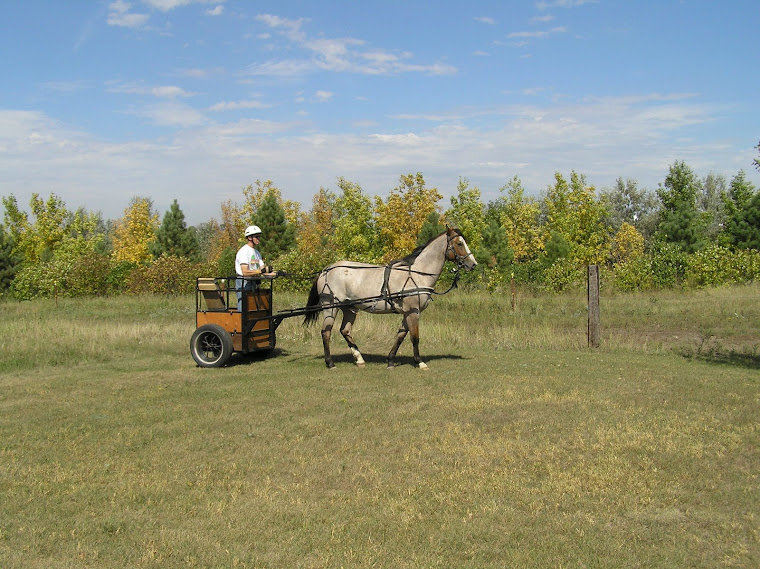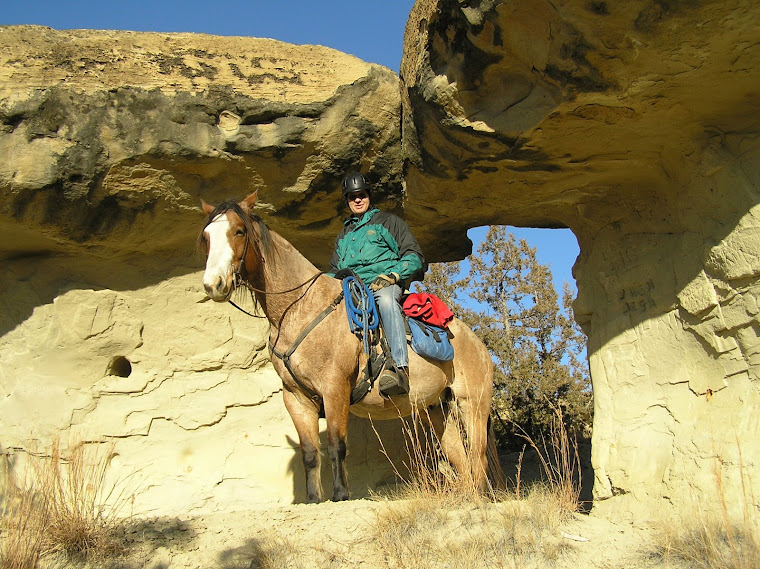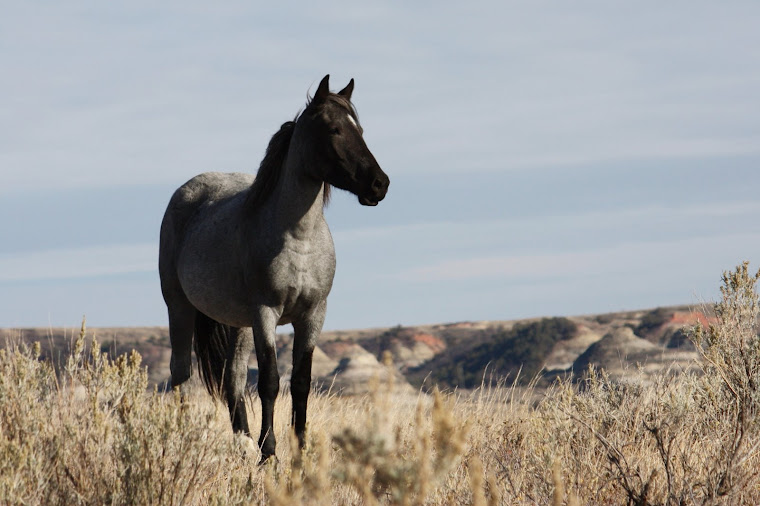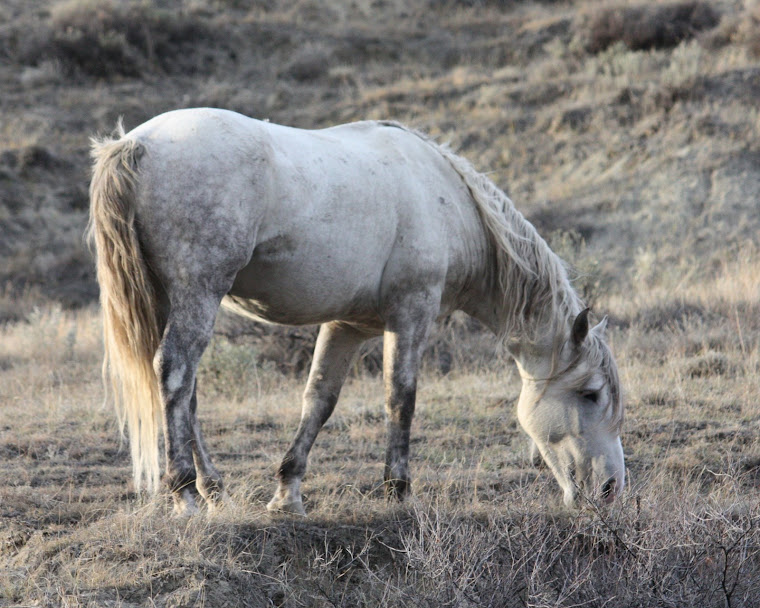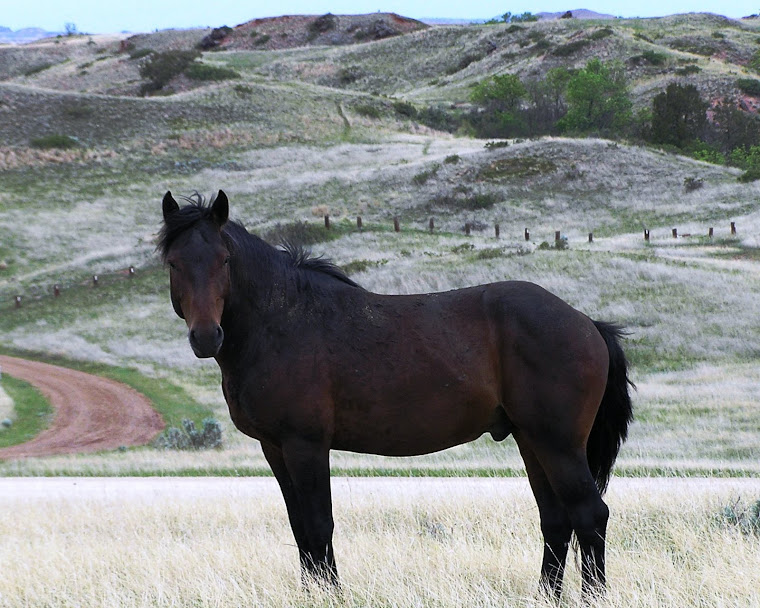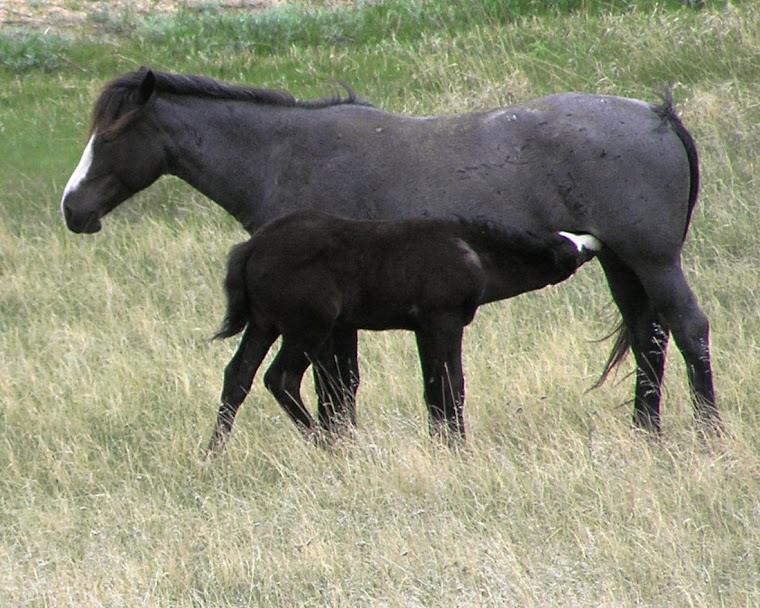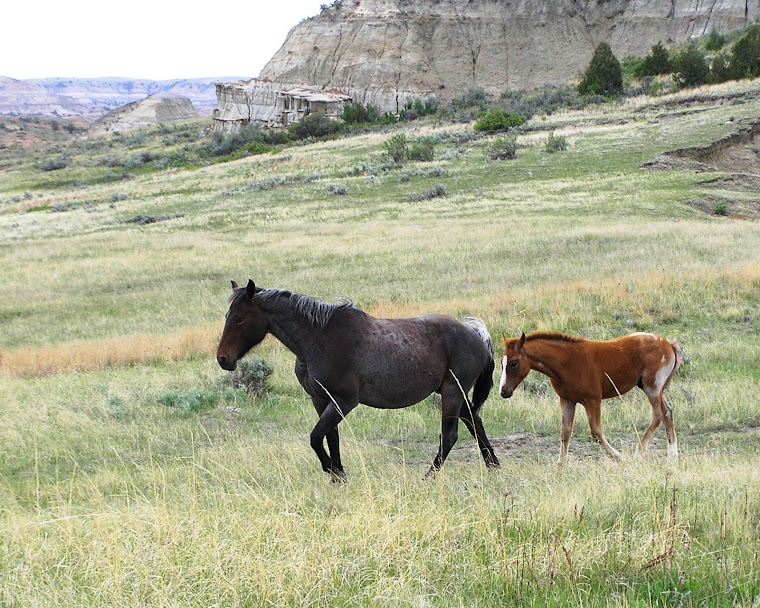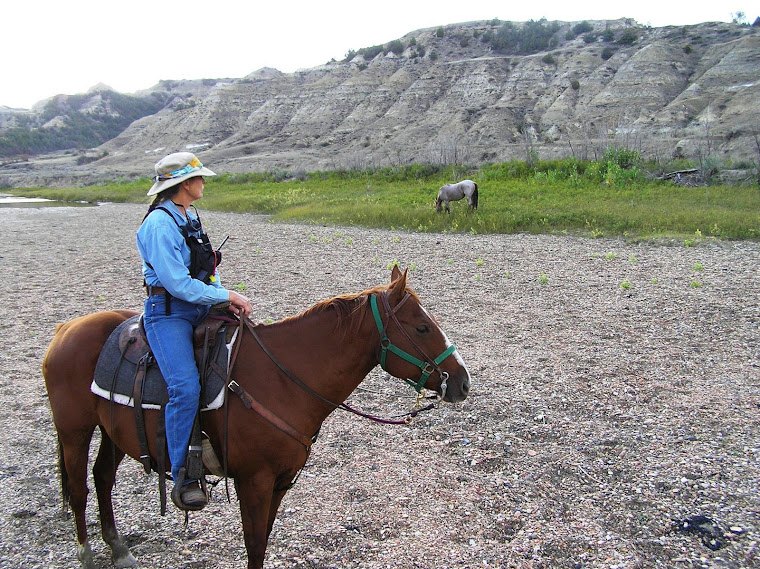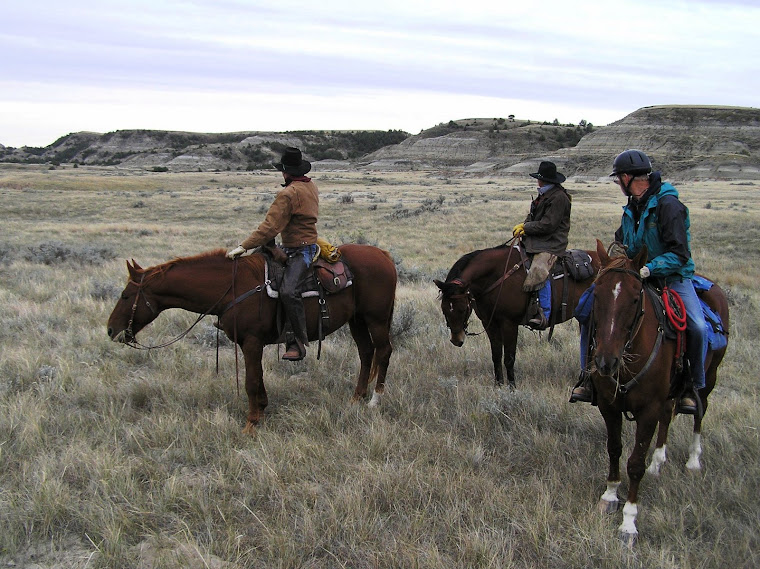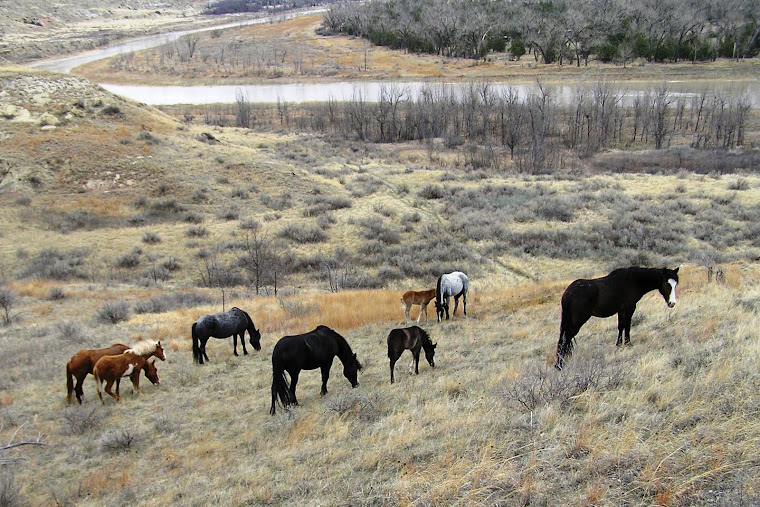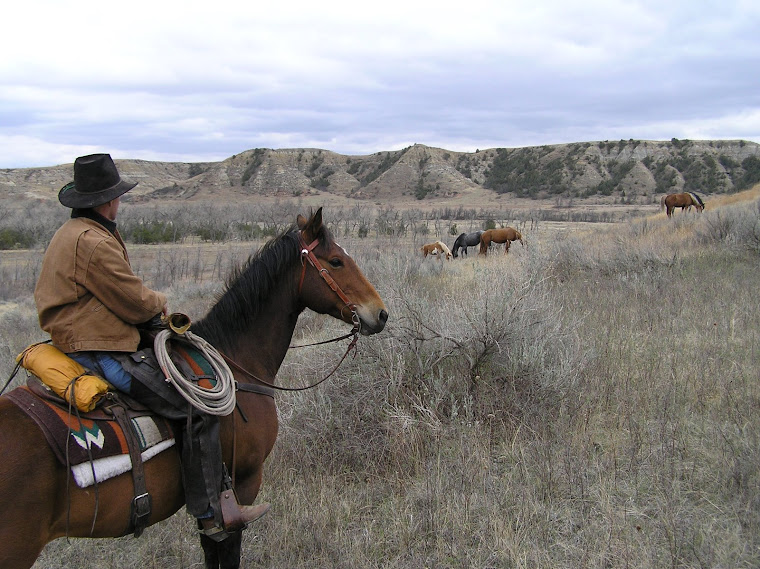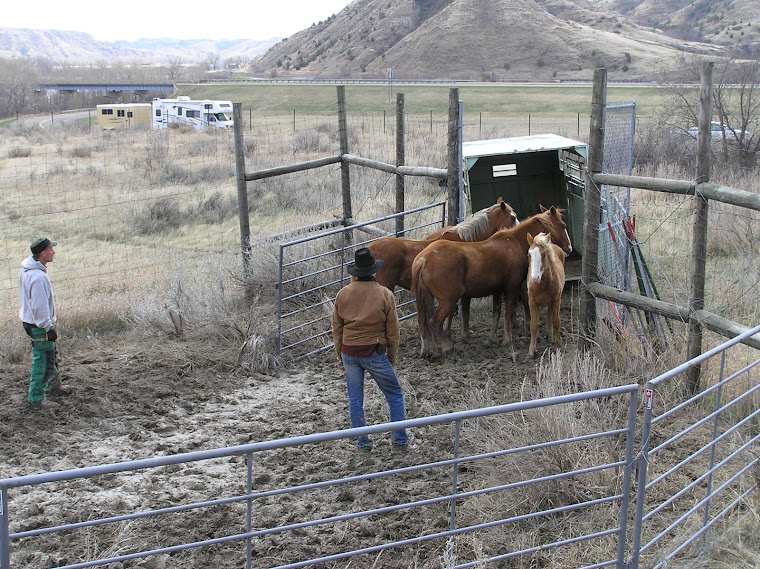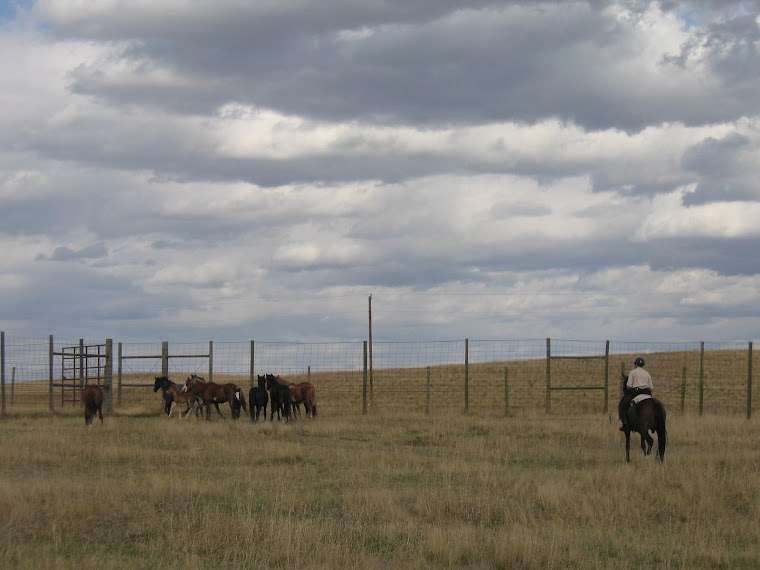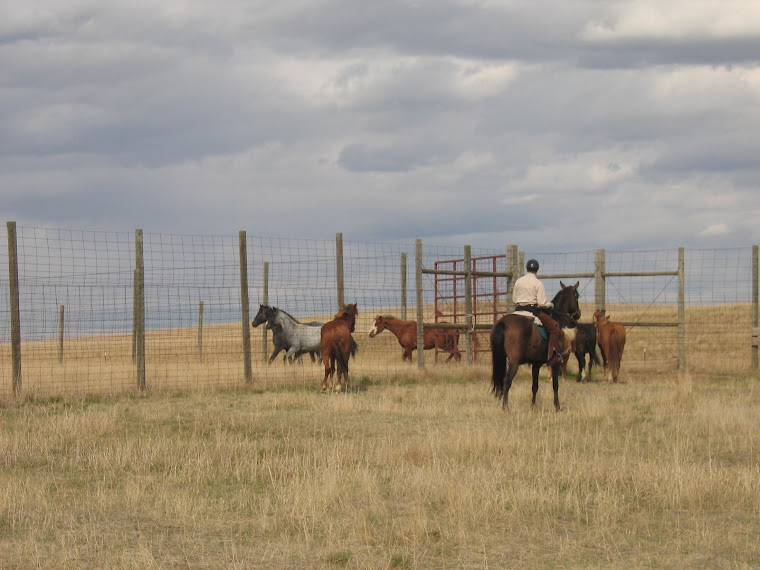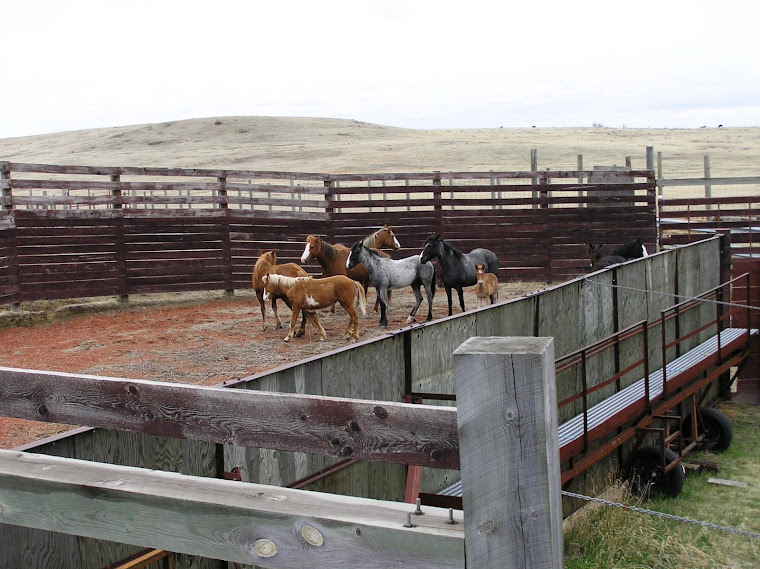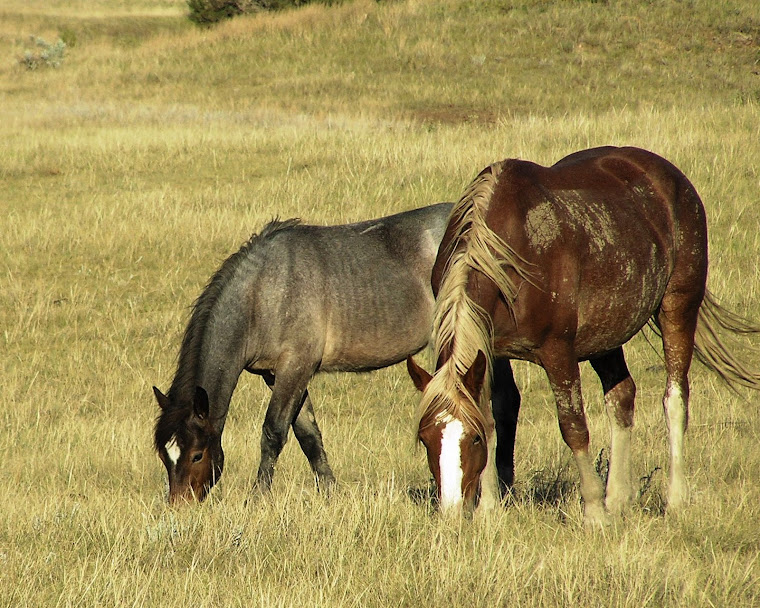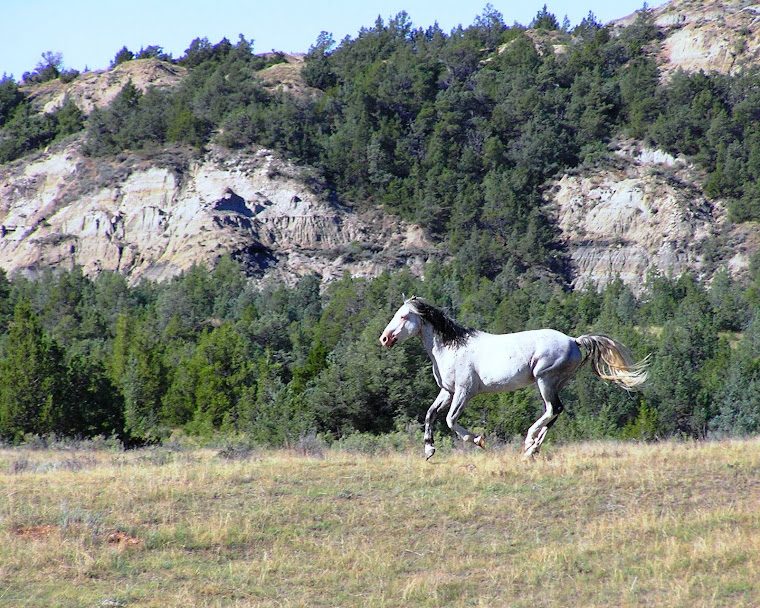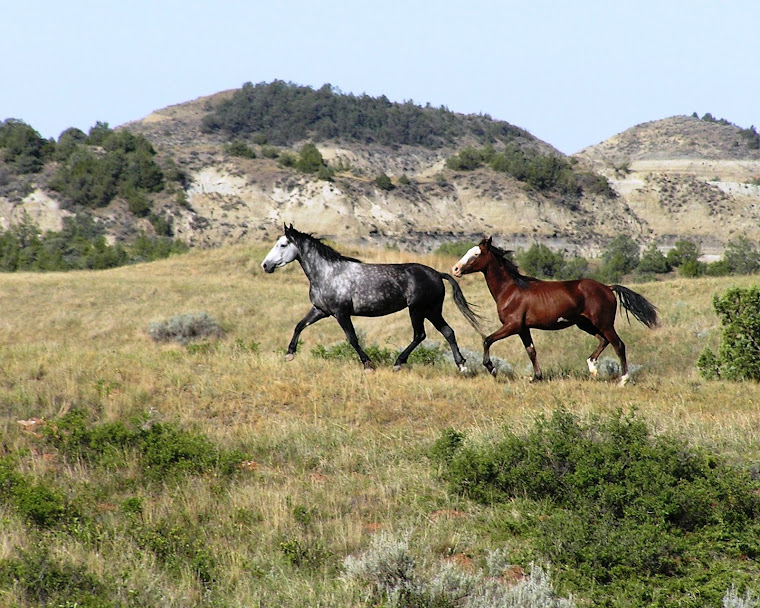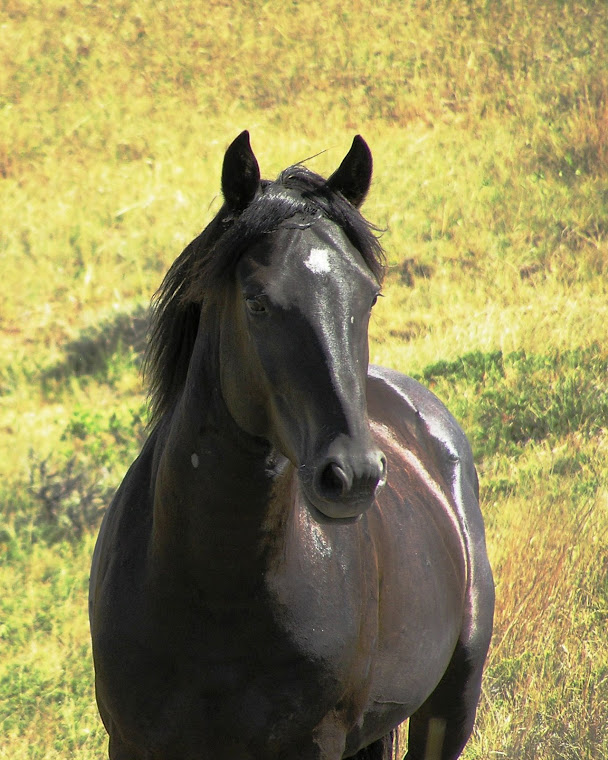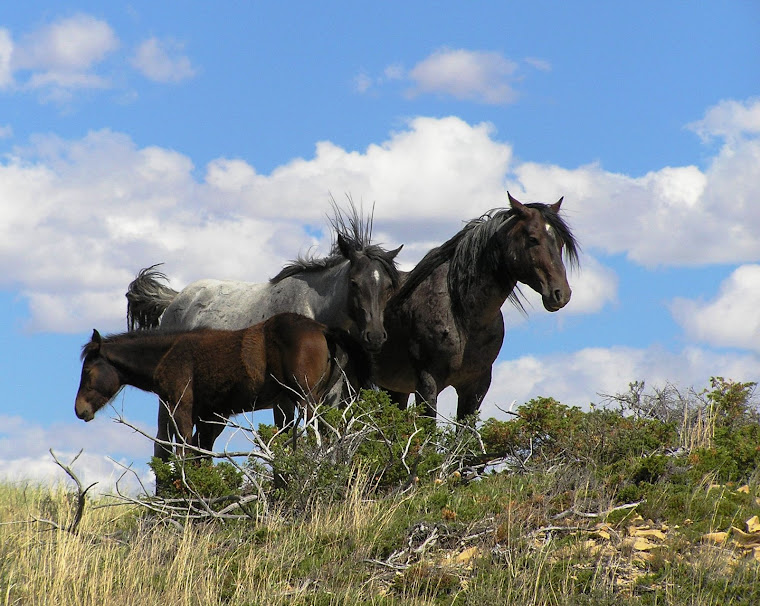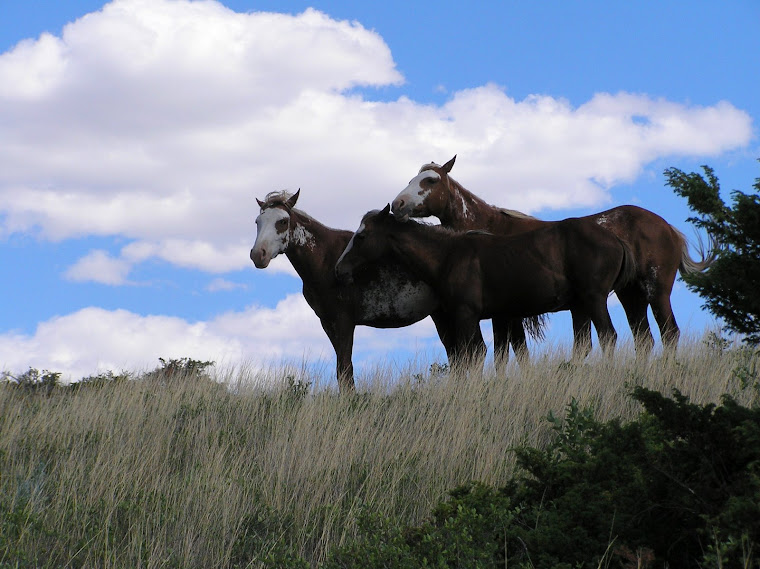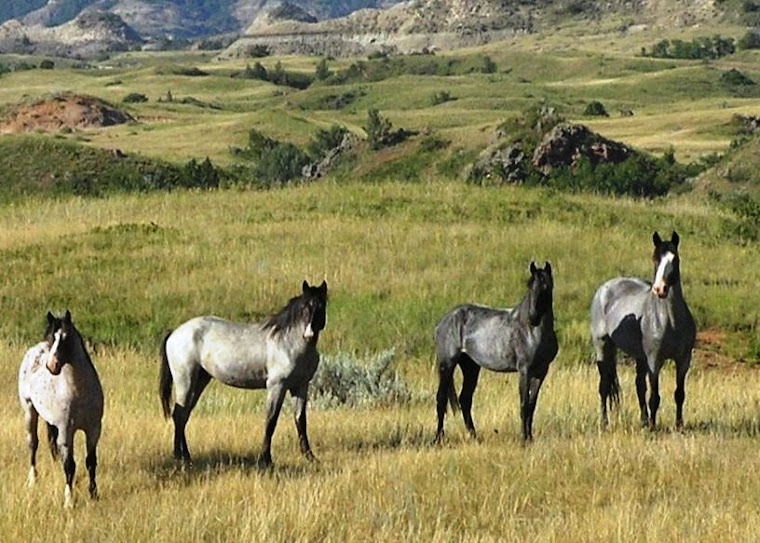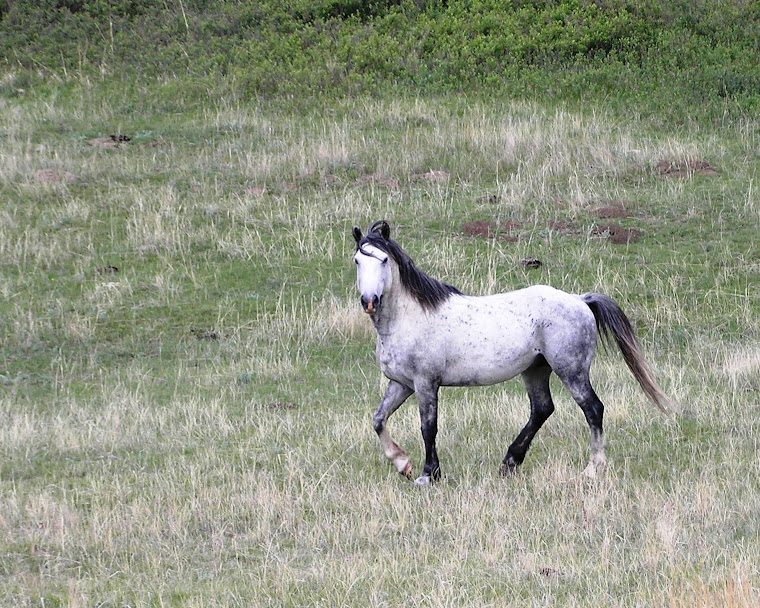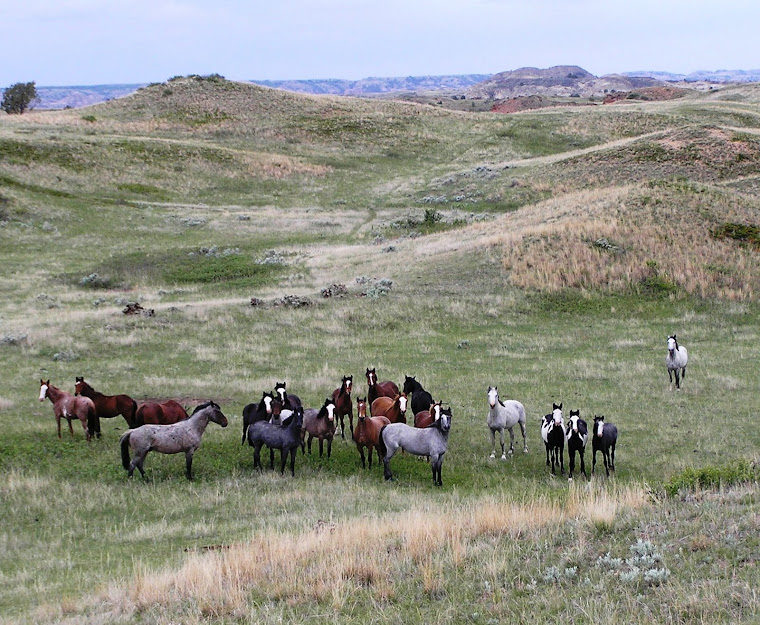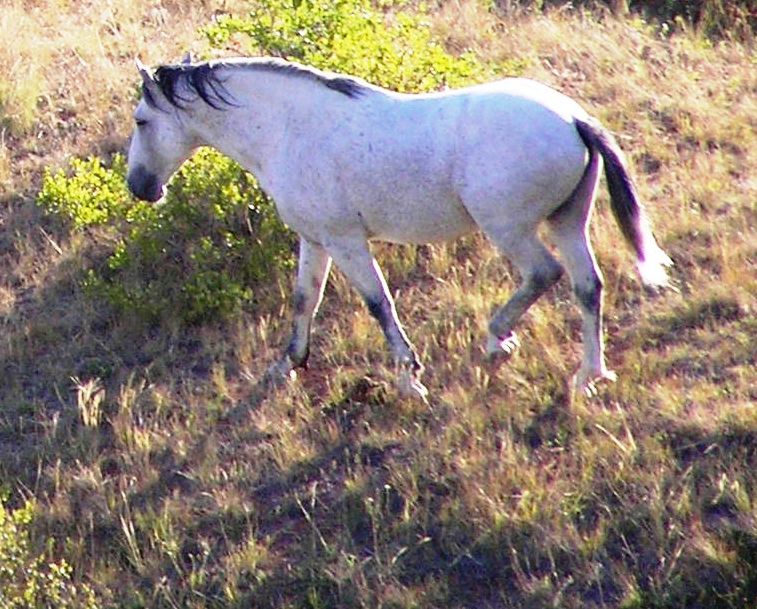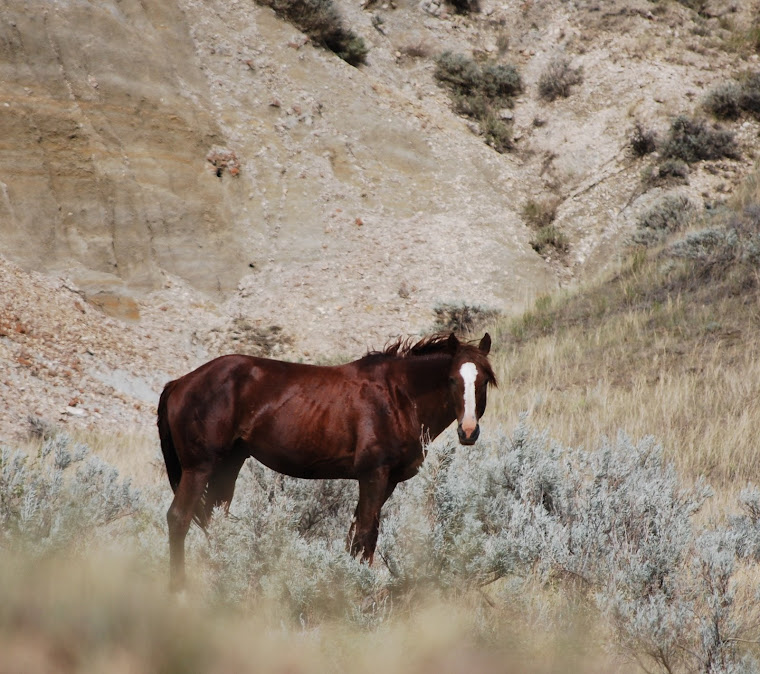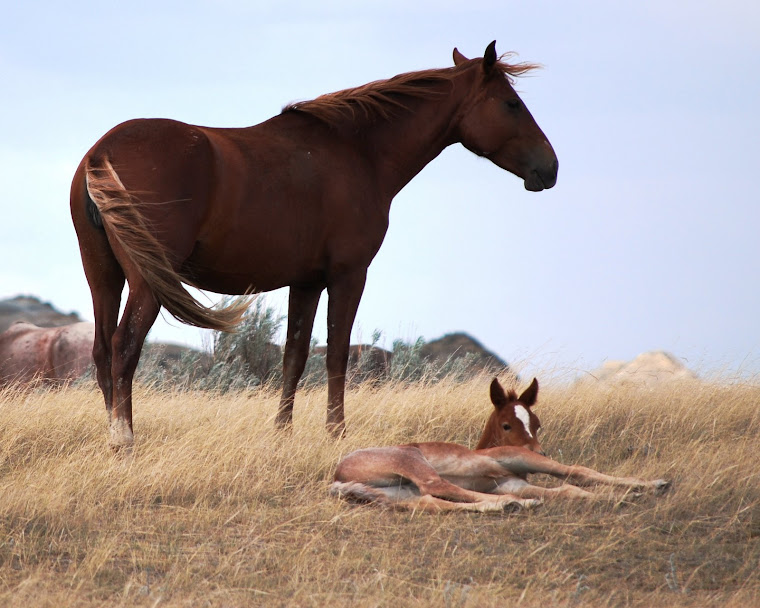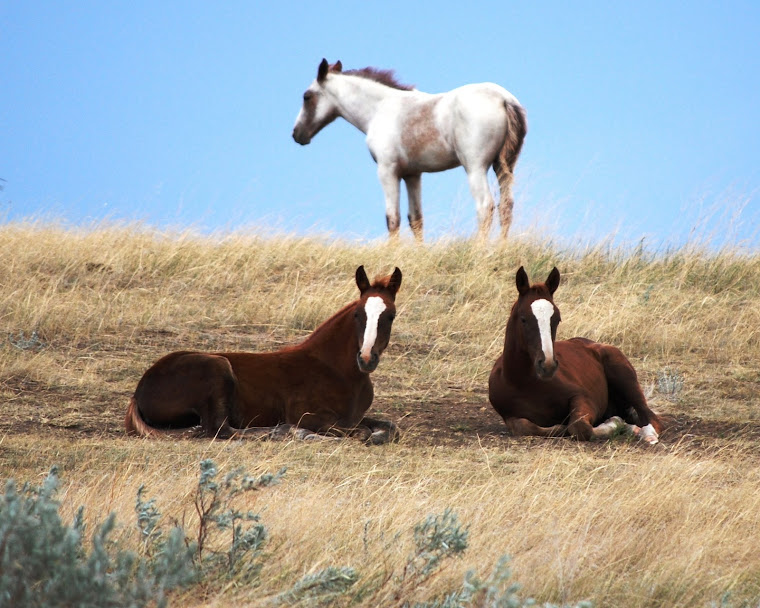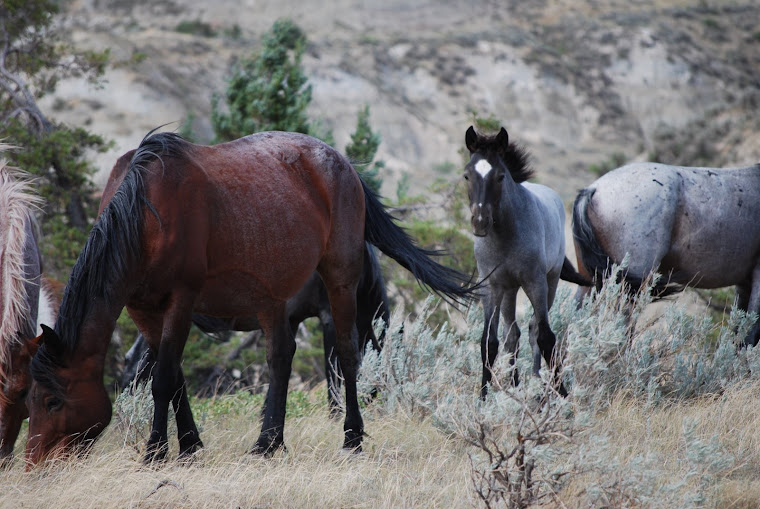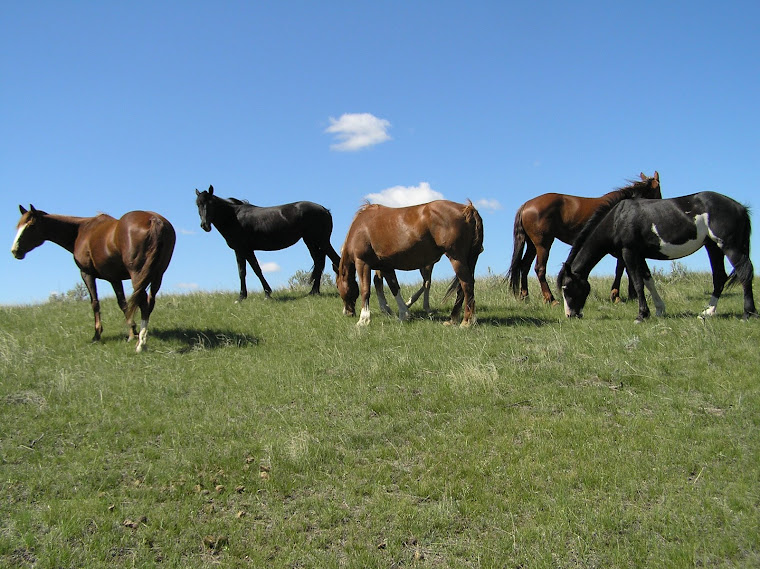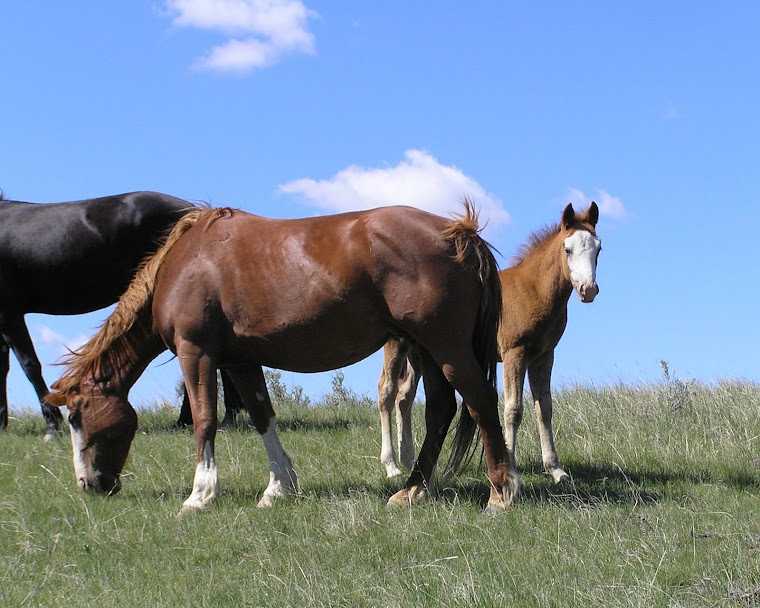If you copy and paste this address you should be able to get the article published by the research team.
http://www.appliedanimalbehaviour.com/article/S0168-1591(14)00135-X/abstract
Saturday, June 7, 2014
THE NORTH DAKOTA BADLANDS HORSE, WILD HORSE OF THEODORE ROOSEVELT NATIONAL PARK
(an overview by Marylu Weber)
Horses have run wild
and free in the upper plains of North America for centuries, having migrated
north from South America and south from Canada.
Native Americans oral history differs on when they acquired the horse,
but when the plains tribes began using horses in their daily living, it changed
their lifestyle forever. They changed
from primarily farmers, living along rivers and streams, growing the majority
of their food and hunting small game, to a nomadic people who could follow the
bison herds. They became experts at
gentling and training horses which they called Sunka Wakan, “sacred dogs,” a
gift from the Creator. Horses were used
as valuable currency when trading with one another.
When Europeans came exploring the
region, they reported seeing great herds of wild horses. They also brought with them, horses from the
east that had been imported to the new world.
Europeans gradually spread across the plains, bringing not only imported
saddle horses, but draft horses to work the farms that sprung up on the rich
land and along rivers and railroads. The US Cavalry built forts to protect new
settlers and their claims. Since horses
were still the main means of transportation, thousands of horses flooded the
northern plains. Wars brought the need
for even more horses, so remount operations were scattered throughout the
region and horses were raised or captured to send back east as mounts for
soldiers, many of them finding their way to Europe for “The Great War.”
During that time of pioneering and
settlement of the plains, it was discovered that the Badlands of Dakota Territory
may be treacherous to cross, but were abundant with rich native grasses that
nourished wildlife and wild horses.
Those same native grasses could support great herds of domestic cattle
and the horses the ranchers needed to handle them. Two of the most famous of those ranchers were
the Marquis De Mores, a rich young Frenchman, and the young Theodore
Roosevelt.
The Marquis settled in what is now SW
North Dakota where the Little Missouri River and the railroad intersected. He named the town of Medora after his wife; their
summer house still stands on a hill overlooking the river. Importing vast numbers of cattle, he built a
packing plant with visions of making millions raising, slaughtering, packing in
ice, and shipping beef back east, thus leaving out the middlemen. To handle the cattle and the daily chores of
his ranch, he imported Thoroughbred and Percheron horses which he bred to the
tough little local ponies. At one point
he bought 250 ponies that had been confiscated from the Lakota Chief, Sitting
Bull. Using his swift horses, he even
started a stage coach service from Medora to Deadwood. There was no doubt the Marquis was a
visionary whose dreams were clever and daring.
The young Theodore Roosevelt came to
the Badlands to hunt, but wound up turning to ranching also. He loved the vastness of the prairie and
credited the years he spent there with building his strength and making him the
man he later became. In his writings he
told about seeing wild horses running free in the Badlands. He built two ranches in the Badlands, the Elk
Horn Ranch and the Maltese Cross Ranch.
Though these men and hundreds of
others thought Dakota Territory was the perfect place to raise cattle and
horses, with its miles of tall grass reaching from horizon to horizon, they
could not imagine the devastation and toll on livestock that could be caused by
drought, and a series of mighty winter storms.
After one particularly brutal winter, one cowboy reported riding for
miles that spring and not seeing a living animal. The Marquis moved back to France, later to be
killed in Africa and Theodore Roosevelt went on to become the 26th
President of the United States.
That year drove hundreds out of the
Badlands, but other immigrants, eager to build a life for their families in the
new world, came to replace them. At one
time, every quarter of land in the Badlands was homesteaded. These homesteaders brought their saddle and
work horses with them as well as cattle and sheep, but Mother Nature would also
drive many of them out of the Badlands with the droughts of the 1930s. Livestock by the thousands were lost or abandoned
by farmers and ranchers retreating to more fertile lands back east.
As trains, automobiles, and tractors
became more numerous, there was no more need for horses. By then the Badlands of North Dakota were
only sparsely inhabited, so thousands of horses, either migrated or were driven
there from other parts of the country.
The bison were long gone, so the horses settled into the rough breaks of
the Little Missouri River from Canada to South Dakota, mingling and breeding
with the herds of wild horses that still remained. The weak died off and the hardy, that could
survive the harsh conditions of drought and blizzards flourished. However their reprieve was not long
lived. Ranchers did not appreciate
horses, which required more forage than a cow, eating up the grass on the open
range. Horses were indiscriminately
hunted down with saddle horses, pickups, or airplanes. Many were killed outright and thousands were
loaded onto railcars to be made into fertilizer in the east. The lucky ones were bought off the trains by
individuals who appreciated the strong, hardy “Northern Horses.”
By the mid-1950s there were very few
horses running wild in the Badlands. Theodore
Roosevelt National Park had been established in 1947 and a boundary fence was
being constructed to keep wildlife in and domestic stock out. As that fence went up, a few small bands of
horses were inadvertently being trapped inside the park. These bands were made up of wild horses and
domestic horses from area ranches. Since
the National Park Service looked on horses as trespass animals, the horses were
again hunted and many of them removed.
There was a large roundup conducted by area ranchers in 1954 in which
almost all the horses were removed from the park. Most of them were domestic horses that had
escaped from ranches or were part of domestic strings that had run in the park
for decades.
Tom Tescher, a local rancher and well
known rodeo cowboy and his brothers had watched and wrangled the wild horses
for years. Along with more positive public
sentiment toward wild horses, Tom was instrumental in the park’s decision to
keep a few horses in the park. The
decision was made to keep a small “demonstration herd” to represent the wild
horses that Theodore Roosevelt had observed when he lived in the area. Tom began to document the horses, keeping
detailed records of births and deaths and which stallions held which
mares. Tom and his brothers helped the
park round up the horses periodically so that numbers could be kept to around
50-100. Culled animals were sometimes sold
to individuals and rodeo contractors, but most of them went to slaughter.
My husband and I started riding in
the park in the early 80s and fell in love with the wild horses we saw. I started to document them and look for familiar
ones each time we returned. In the 90s
we met then Resource Manager, Russ Runge, who introduced us to Tom Tescher who
graciously invited us into his home and his pickup for horse tracking
adventures and shared all his records with us. I started making spreadsheets with
information about each horse and in 1999 we began volunteering for the park in helping
Tom with the identification and documentation of the wild herd. Since then we have worked at every
roundup. I have been the principle
identifier of all the horses at each of the 5 roundups since then.
The horses are rounded up by
helicopter because the terrain is so rough that it cannot be done safely on
horseback. Until the last three
roundups, riders were used the last mile in order to lure the horses into the
trap, but that was deemed too dangerous and discontinued in 2003. The park has a permanent trap and handling
facility that is used for elk and bison as well as horses. Pens are high and solid wood so animals are
not temped to try to get out. Each year the
roundups have gotten more humane. The
2007 roundup ended early with the crash of the helicopter because it was too
low and caught a skid on the fence, but neither horses nor people were injured. There were no injuries to either horses or
people in any of the last 3 roundups.
In 2009 a research project was
initiated to find a reliable contraceptive to prevent pregnancy on a temporary
basis and avoid side effects that would cause harm or behavior changes with the
horses. During the breeding season of
each year since 2009, technicians have observed behavior, pregnancy status,
condition, and any possible side effects of the contraceptive. These data have been compiled and processed
by researchers in order to determine the effectiveness of the drug and any
changes that should be made. In the fall
of 2009, 58 mares were injected with either the contraceptive or a placebo and
data was collected at least once a week from March until July each of the
following years. In 2013 treated mares
were re-vaccinated to test the efficacy of the contraceptive when boosted.
After the roundup in 2009, 77 horses
were sold to the public. Because of the
efforts of a few passionate people, all but 8 of those horses were bought by
individuals who gave them a home.
That winter North Dakota Badlands
Horse Registry was established to provide a registry and a network of
communication and support for the buyers of those horses. Our goal is that no more horses will
be lost to slaughter, but all will find good homes where they will be
appreciated and gentled. We registered
about 30 horses and created a Facebook page to share stories and photos of the
horses. As photos and stories are shared
more and more people are beginning to appreciate the wild horses of TRNP.
Over the past 5 years we have
attracted a large group of enthusiastic people who love the horses. In September of 2013 we had our first Reunion
Ride of horses that were once running wild in the park. Ten once wild horses were ridden back in
their homeland. Other activities were
held for owners and enthusiasts. This
will be an annual event in Medora and the park.
The 2014 Reunion Ride is scheduled for the weekend of September 5-7. In the months leading up to another roundup
in September of 2013, NDBH stepped up our Facebook campaign to reach as many
people as possible with the plight of the horses being removed from the
park. We were able to bring in The Cloud
Foundation and Legacy Mustang Preservation to help us tell the story of the
wild horses of Theodore Roosevelt National Park. Both organizations raised money to buy unwanted
horses and Legacy was prepared to take those horses to their facility in
Louisa, VA to gentle them, train them, and eventually offer them to forever
adoptive homes. Ginger Kathrens of the
Cloud Foundation wrote press releases and made videos about the plight of the
TRNP horses. We are humbled and grateful
to both organizations and the people involved in them for caring so much about
the TRNP horses that they would work so hard, shoulder to shoulder with us to
see that the horses were not lost. Our
relationship with The Cloud Foundation and Legacy Mustang Preservation grows as
we support one another in the effort to help the wild horses of America.
The public auction was in a small
town in ND, but Wishek rolled out the red carpet for us and the potential
buyers of the wild horses. The horse
sale manager of Wishek Livestock Auction did everything he could to make the
horses safe and comfortable, even having his talented cowboys practice gently
moving the horses from pen to pen and through the auction ring. Wanting to welcome all the visitors from far
away, the town of Wishek had a celebratory approach to the sale with activities
in which all could participate. NDBH had
depended upon and become friends with so many people during this campaign that
we called ourselves TEAM NDBH, knowing that the job of saving these beautiful
wild horses had to be a joint effort by many, many individuals. TEAM NDBH succeeded in seeing that none of
the wild horses went to slaughter.
Horses were sold at a minimum of untainted slaughter price ($.42/ lb.),
so that the meat buyers would not be interested. Horses went to homes all over the country and
Canada, including 35 to Legacy Mustang Preservation in VA. About 15 of those were bought by a private
buyer but the other 20 might have gone to slaughter if not purchased with
donated funds. About 20 horses will be
available for adoption from Legacy as they get them gentled and halter trained.
Five of the mares bought by Legacy have
since had healthy foals.
During the festivities before the
horse sale, NDBH had a silent and live auction of donated artwork to help pay
for DNA testing on the wild horses. Hair
was pulled on all 197 horses that came through the handling facility. (Only 16 did not get captured.) We are confident that the results will be
consistent with that found by several individuals who have had ancestral DNA
reports done on their privately owned NDBH horses, and those results have been
very interesting. There is a surprising
amount of Spanish influence still evident in the wild horses from the
park. There is also strong Oriental, Scandinavian,
and other eastern and western European influence along with some North and South
American breed connections. They are
definitely showing themselves to be mustangs with the typical mix of blood from
many diverse sources. One hundred
eleven horses remained in the park in about 20 different bands. They will again be documented and evaluated
by researchers in the coming years. The
foal count as of early June is 31 live foals.
Ranging in size from 13 –16 hands,
the horses come in most colors, with grays and red, bay, and blue roans the
most prevalent. Many carry the overo
traits of patches of white on dark coats, bald faces, and blue eyes. There are no tobiano pintos and no palominos
in this wild herd. Most are of sturdy
build, with good bone and large, healthy feet.
They tend to be healthy in other respects, as the sickly horses do not
survive in the wild. When gentled, the
horses from TRNP have proven themselves to be mellow, sensible, highly trainable,
loyal partners to those lucky enough to know them. The consistent feeling among owners is that
they love these horses.
Please visit the Facebook page, North Dakota Badlands Horse
for regular updates on the horses remaining in the park and many of those being
successfully gentled and trained by happy owners who are so thrilled to be a
part of the history of these beautiful horses.
Subscribe to:
Posts (Atom)


